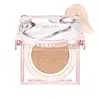What's inside
What's inside
 Key Ingredients
Key Ingredients

 Benefits
Benefits

 Concerns
Concerns

 Ingredients Side-by-side
Ingredients Side-by-side

Cyclopentasiloxane
EmollientWater
Skin ConditioningButylene Glycol
HumectantGlycerin
HumectantDimethicone
EmollientPolymethylsilsesquioxane
Triethylhexanoin
MaskingDimethicone/Vinyl Dimethicone Crosspolymer
Skin ConditioningPEG-10 Dimethicone
Skin ConditioningBis-Butyldimethicone Polyglyceryl-3
CleansingDisteardimonium Hectorite
StabilisingCurcuma Longa Root Extract
MaskingAscorbyl Glucoside
AntioxidantPaeonia Albiflora Root Extract
Skin ConditioningTocopherol
AntioxidantSorbitan Sesquiisostearate
EmulsifyingSodium Glutamate
Masking1-Methylhydantoin-2-Imide
Skin ConditioningSodium Dehydroacetate
PreservativeAluminum Hydroxide
EmollientPolysilicone-2
Triethoxycaprylylsilane
Ethylhexylglycerin
Skin ConditioningGlucosyl Hesperidin
HumectantBenzoic Acid
MaskingChlorphenesin
AntimicrobialPhenoxyethanol
PreservativeIron Oxides
CI 77492
Cosmetic ColorantCI 77499
Cosmetic ColorantCI 77891
Cosmetic ColorantCyclopentasiloxane, Water, Butylene Glycol, Glycerin, Dimethicone, Polymethylsilsesquioxane, Triethylhexanoin, Dimethicone/Vinyl Dimethicone Crosspolymer, PEG-10 Dimethicone, Bis-Butyldimethicone Polyglyceryl-3, Disteardimonium Hectorite, Curcuma Longa Root Extract, Ascorbyl Glucoside, Paeonia Albiflora Root Extract, Tocopherol, Sorbitan Sesquiisostearate, Sodium Glutamate, 1-Methylhydantoin-2-Imide, Sodium Dehydroacetate, Aluminum Hydroxide, Polysilicone-2, Triethoxycaprylylsilane, Ethylhexylglycerin, Glucosyl Hesperidin, Benzoic Acid, Chlorphenesin, Phenoxyethanol, Iron Oxides, CI 77492, CI 77499, CI 77891
Water
Skin ConditioningDiphenylsiloxy Phenyl Trimethicone
Skin ConditioningCI 77891
Cosmetic ColorantEthylhexyl Methoxycinnamate
UV AbsorberPropylene Glycol Dibenzoate
Skin ConditioningCyclopentasiloxane
EmollientEthylhexyl Salicylate
UV AbsorberCetyl PEG/PPG-10/1 Dimethicone
EmulsifyingGlycerin
HumectantPolyglyceryl-4 Diisostearate/Polyhydroxystearate/Sebacate
EmulsifyingMethyl Hydrogenated Rosinate
PerfumingNiacinamide
SmoothingTridecyl Trimellitate
EmollientIsododecane
Emollient1,2-Hexanediol
Skin ConditioningDipentaerythrityl Pentaisostearate
EmollientHydrolyzed Hyaluronic Acid
HumectantCollagen Extract
Skin ConditioningHydrogenated Polyisobutene
EmollientStearalkonium Hectorite
Gel FormingMagnesium Sulfate
Synthetic Fluorphlogopite
Polyglyceryl-4 Isostearate
EmulsifyingStearic Acid
CleansingAlumina
AbrasiveIsopropyl Titanium Triisostearate
EmollientAluminum Hydroxide
EmollientAdenosine
Skin ConditioningTrisodium Ethylenediamine Disuccinate
Trimethoxycaprylylsilane
SmoothingPhytosterols
Skin ConditioningParfum
MaskingHexyl Cinnamal
PerfumingAlpha-Isomethyl Ionone
PerfumingHydroxycitronellal
PerfumingCI 77492
Cosmetic ColorantCI 77491
Cosmetic ColorantCI 77499
Cosmetic ColorantWater, Diphenylsiloxy Phenyl Trimethicone, CI 77891, Ethylhexyl Methoxycinnamate, Propylene Glycol Dibenzoate, Cyclopentasiloxane, Ethylhexyl Salicylate, Cetyl PEG/PPG-10/1 Dimethicone, Glycerin, Polyglyceryl-4 Diisostearate/Polyhydroxystearate/Sebacate, Methyl Hydrogenated Rosinate, Niacinamide, Tridecyl Trimellitate, Isododecane, 1,2-Hexanediol, Dipentaerythrityl Pentaisostearate, Hydrolyzed Hyaluronic Acid, Collagen Extract, Hydrogenated Polyisobutene, Stearalkonium Hectorite, Magnesium Sulfate, Synthetic Fluorphlogopite, Polyglyceryl-4 Isostearate, Stearic Acid, Alumina, Isopropyl Titanium Triisostearate, Aluminum Hydroxide, Adenosine, Trisodium Ethylenediamine Disuccinate, Trimethoxycaprylylsilane, Phytosterols, Parfum, Hexyl Cinnamal, Alpha-Isomethyl Ionone, Hydroxycitronellal, CI 77492, CI 77491, CI 77499
 Reviews
Reviews

Ingredients Explained
These ingredients are found in both products.
Ingredients higher up in an ingredient list are typically present in a larger amount.
Aluminum Hydroxide is a form of aluminum. It can be naturally found in nature as the mineral gibbsite. In cosmetics, Aluminum Hydroxide is used as a colorant, pH adjuster, and absorbent.
As a colorant, Aluminum Hydroxide may add opacity, or reduce the transparency. Aluminum hydroxide is contains both basic and acidic properties.
According to manufacturers, this ingredient is an emollient and humectant. This means it helps hydrate the skin.
In medicine, this ingredient is used to help relieve heartburn and help heal ulcers.
There is currently no credible scientific evidence linking aluminum hydroxide in cosmetics to increased cancer risk.
Major health organizations allow the use of aluminum hydroxide in personal care products and have not flagged it as a carcinogenic risk at typical usage levels.
Learn more about Aluminum HydroxideCi 77492 is also hydrated iron III oxide. It's sole purpose is to give a yellow hue to products.
Iron III oxides are classified as inorganic chemicals for coloring.
Synthetically created Ci 77492 is considered safer than those naturally found. This is because the synthetically created version may contain less impurities. Iron oxides are generally non-toxic and non-allergenic.
Learn more about CI 77492Ci 77499 is also hydrated iron III oxide. It is created from mixing red and black iron oxides. This helps give shades of darkness to a product.
Iron III oxides are classified as inorganic chemicals for coloring.
Ci 77891 is a white pigment from Titanium dioxide. It is naturally found in minerals such as rutile and ilmenite.
It's main function is to add a white color to cosmetics. It can also be mixed with other colors to create different shades.
Ci 77891 is commonly found in sunscreens due to its ability to block UV rays.
Learn more about CI 77891Cyclopentasiloxane, or D5, is a silicone used to improve texture of products and trap moisture.
D5 is considered lightweight and volatile. Volatile means it evaporates quickly after application. Once evaporated, D5 leaves a thin barrier that helps keep skin hydrated.
It is also an emollient. Emollients help soften the skin and prevent water loss. Silicones create a silky texture in products. D5 helps other ingredients become more spreadable.
Studies show D5 is safe to use in skincare products. We recommend speaking with a skincare professional if you have concerns.
Learn more about CyclopentasiloxaneGlycerin is already naturally found in your skin. It helps moisturize and protect your skin.
A study from 2016 found glycerin to be more effective as a humectant than AHAs and hyaluronic acid.
As a humectant, it helps the skin stay hydrated by pulling moisture to your skin. The low molecular weight of glycerin allows it to pull moisture into the deeper layers of your skin.
Hydrated skin improves your skin barrier; Your skin barrier helps protect against irritants and bacteria.
Glycerin has also been found to have antimicrobial and antiviral properties. Due to these properties, glycerin is often used in wound and burn treatments.
In cosmetics, glycerin is usually derived from plants such as soybean or palm. However, it can also be sourced from animals, such as tallow or animal fat.
This ingredient is organic, colorless, odorless, and non-toxic.
Glycerin is the name for this ingredient in American English. British English uses Glycerol/Glycerine.
Learn more about GlycerinWater. It's the most common cosmetic ingredient of all. You'll usually see it at the top of ingredient lists, meaning that it makes up the largest part of the product.
So why is it so popular? Water most often acts as a solvent - this means that it helps dissolve other ingredients into the formulation.
You'll also recognize water as that liquid we all need to stay alive. If you see this, drink a glass of water. Stay hydrated!
Learn more about Water